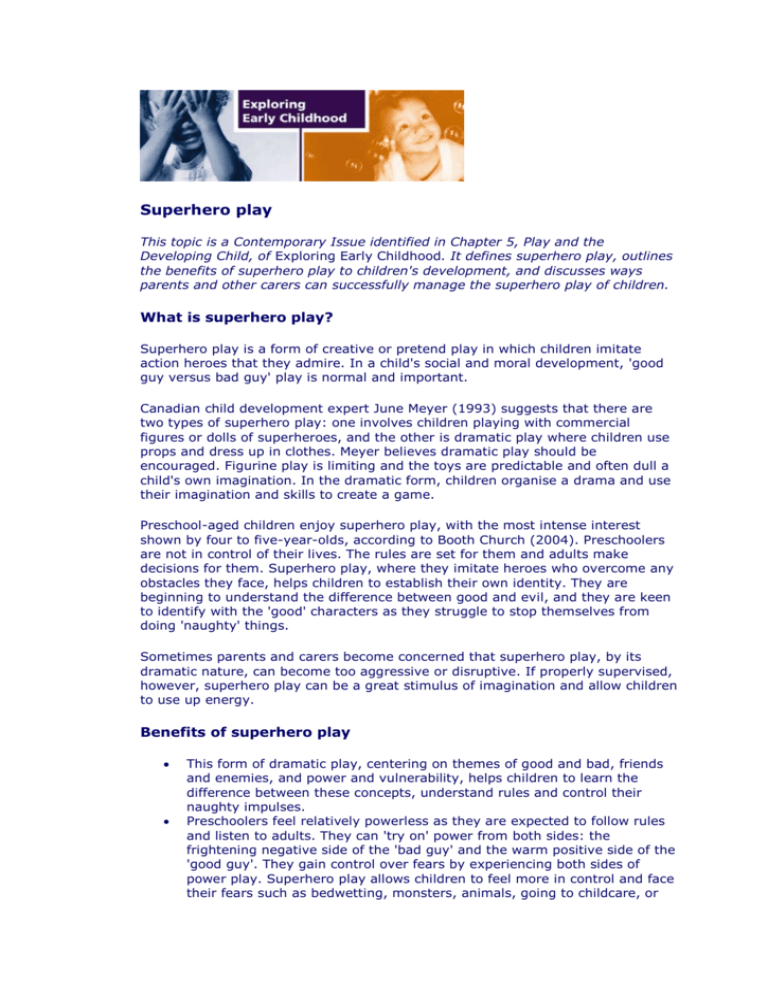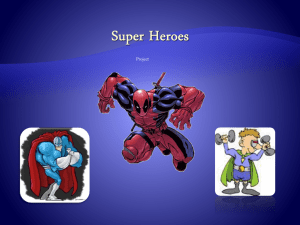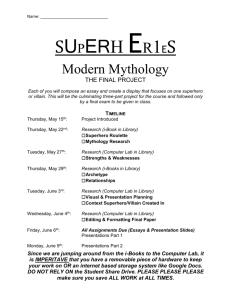Superhero play - Pearson Places
advertisement

Superhero play This topic is a Contemporary Issue identified in Chapter 5, Play and the Developing Child, of Exploring Early Childhood. It defines superhero play, outlines the benefits of superhero play to children's development, and discusses ways parents and other carers can successfully manage the superhero play of children. What is superhero play? Superhero play is a form of creative or pretend play in which children imitate action heroes that they admire. In a child's social and moral development, 'good guy versus bad guy' play is normal and important. Canadian child development expert June Meyer (1993) suggests that there are two types of superhero play: one involves children playing with commercial figures or dolls of superheroes, and the other is dramatic play where children use props and dress up in clothes. Meyer believes dramatic play should be encouraged. Figurine play is limiting and the toys are predictable and often dull a child's own imagination. In the dramatic form, children organise a drama and use their imagination and skills to create a game. Preschool-aged children enjoy superhero play, with the most intense interest shown by four to five-year-olds, according to Booth Church (2004). Preschoolers are not in control of their lives. The rules are set for them and adults make decisions for them. Superhero play, where they imitate heroes who overcome any obstacles they face, helps children to establish their own identity. They are beginning to understand the difference between good and evil, and they are keen to identify with the 'good' characters as they struggle to stop themselves from doing 'naughty' things. Sometimes parents and carers become concerned that superhero play, by its dramatic nature, can become too aggressive or disruptive. If properly supervised, however, superhero play can be a great stimulus of imagination and allow children to use up energy. Benefits of superhero play This form of dramatic play, centering on themes of good and bad, friends and enemies, and power and vulnerability, helps children to learn the difference between these concepts, understand rules and control their naughty impulses. Preschoolers feel relatively powerless as they are expected to follow rules and listen to adults. They can 'try on' power from both sides: the frightening negative side of the 'bad guy' and the warm positive side of the 'good guy'. They gain control over fears by experiencing both sides of power play. Superhero play allows children to feel more in control and face their fears such as bedwetting, monsters, animals, going to childcare, or parents divorcing. Pretending to be a brave superhero can help children imagine what frightening experiences are like and be more comfortable trying new things. It gives them courage and strength. For example, children may insist on wearing a Superman costume to make them feel safe and in control. Young children can use superhero play to help make sense of confusing experiences and understand their place in the world. It helps children establish their own individuality. Superhero play helps children develop problem-solving skills as they examine lots of possible solutions to a problem. Children learn about cooperation and team work as they sequence a story together, negotiate how play will proceed, and solve problems as a group. As with other forms of pretend play, superhero play helps children use and develop language skills. Their vocabulary is expanded as they interact with other children and supervising adults. Superhero play assists children's socialisation. Curtis (2003) explains that children who are involved in managed superhero play interact better with adults, and feel a sense of belonging in a group. By pretending to be someone else, children imagine how others feel and become aware of the needs of others and the reasons why people behave as they do. Superhero play gives children first-hand experience in empathy. Creativity is encouraged through superhero play. Children play at imaginary games for longer and develop more involved plots and scenarios. Superhero play assists physical development as children jump, run and actively imitate the superhuman traits of their heroes. Physical confidence grows as children show off their physical feats. Managing superhero play To enable children to gain the most from superhero play, and to keep it controlled and avoid chaos, parents and carers can follow these guidelines. Set reasonable limits and rules. Make it clear that aggressive behaviour is not acceptable, and let children know when and where superhero play is allowed. Outside is best and remind children that safety comes first, so talk about what actions may be unsafe, such as jumping off the fence. Be involved in the play. In this way you can intervene when things become aggressive or dangerous, or when children become scared or angry. You can become part of the game, offer new options and experience play from the child's own viewpoint. Encourage open communication with children. Talk about the game (after it has finished) and ask your child to share his or her feelings. Also, explain why you don't like it when he or she pretends to hurt or kill someone and help him or her to find alternatives to problem solving and conflict resolution. Limit the aggressive superhero shows children watch. Monitor the television children watch. Watch these shows with children and talk about what is happening and how the shows are made. Media Awareness Network explain that pointing out the predictable stories and characters of the shows can reduce the power the show holds for children. By limiting passive television watching, children also have more time for creative and interactive play in a supportive environment. Provide other environments for children to express themselves. Use clay to pound out anger, or dance to burn excess energy. These are other ways that children can be powerful and control the game. Encourage imaginative and creative aspects of superhero play. Help children to be active and develop new plots that allow for action without fighting. Media Awareness Network also suggest that creating costumes, props and settings can be a very important part of the play. Talk about real heroes. Use newspaper stories, television news and other media to discuss that real heroes are brave, helpful and caring. Help children to become heroes themselves - raise money for SIDS, take part in a charity walk together. Help children see the positive qualities of superheroes, not just their physical powers. Emphasise when superheroes show kindness and help others, and praise children when they do the same. Offer children alternative superheroes who use peaceful methods and ingenuity to solve problems. The ABC program, Save-ums, stars 'pint-sized superheroes who race to the rescue to solve preschool-sized emergencies through collaborative problem solving, critical thinking, and the creative use of technology. These colourful 3D animated characters offer kids an opportunity to feel safe in an exciting adventure world that is bursting with thrills, comedy and challenges.' (ABC Kids Shows, 2004). These types of superheroes target those children who most enjoy superhero play preschoolers - and provide them with positive role models. The Save-ums' motto is 'Small is powerful - Believe It!'. Give children choices and power in their lives. Let children feel responsibility and autonomy in making decisions, such as choosing what colour shirt to wear or which playground to visit. Stress peaceful problem-solving. Talk about conflict resolution skills and practise these skills with children. Discuss how these skills can be applied to situations depicted in superhero shows. Don't give in and buy every new superhero toy. Show children how to play with characters they already have in different ways, such as involving the 'good guys' and the 'bad guys' in a rescue mission together), and choose toys that allow children to use them in a number of ways, such as Lego or Mobilo. Develop a child's sense of self-worth and affirm his or her own power. Praise children when they accomplish real achievements, such as completing a puzzle or learning how to tie shoe laces. Also recognise their strength and physical abilities in the same way. Talk about what it means to be a friend. Highlight the importance of accepting differences in others and help children to rotate roles in superhero play so that everyone has a turn at being the 'good guy' and the 'bad guy'. References ABC Kids Shows (2004) 'The Save-ums', at http://www.abc.net.au/ (27 April 2004) Booth Church, E (-) 'When good kids play the bad guy', at http://www.scholastic.com (1 April 2004) Curtis, P (2003) 'Why toy guns are back in the classroom', at http://www.guardian.co.uk/education (21 April 2004) De Gaetano, G (-) 'Acceptable superhero play' at http://www.scn.org/ (21 April 2004) Haddam, J (2001) 'Preschool Passions' at http://www.parents.com/ (24 April 2004) Hewitt, D (1997) So this is normal too?, Redleaf Press, USA Kid Source (-) 'When children imitate superheroes', at http://www.kidsource.com/parenting/imitate.hero.html (1 April 2004) Media Awareness Network (-) 'Managing superhero play', Tip Sheet at http://www.media-awareness.ca/ (1 April 2004) Parenting Preschoolers, Issue #3, 'War play, gun play, superhero and violent play … why won't it go away?' at http://www.ext.nodak.edu/extnews/pipeline/pp-3w.htm (1 April 2004) Rossmanith, A (1997) When will the children play?, Reed Books, Melbourne.






